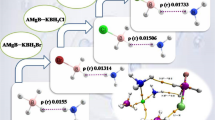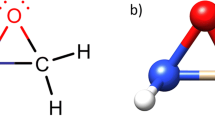Abstract
Noncovalent dimer and trimer adducts obtained from interaction of nido-C4B2H6 with one and two HF molecules were investigated at MP2/aug-cc-pVTZ computational method. In the trimer adducts, two types of geometrical structures were observed. In one kind, no interaction occurred among HF molecules, while in the other ones HF molecules affected the cluster’s stabilities through their hydrogen bonding. The most stable dimer and trimer complexes were related to those structures in which HF molecules had interaction with C4B2H6 from its basal plane. In the trimer complexes, structure, energy, and the spectral characteristics of C4B2H6–HF dimers were significantly influenced by type of its interaction with secondary HF molecule. The interaction energies illustrated weak diminutive and cooperative effects repeatedly. The most stable complexes displayed cooperative effects, while the most unstable ones displayed diminutive effects. Quantum Theory of Atoms in Molecules (QTAIM) was used to investigate and analyze the essence and types of intermolecular interaction in optimized complexes.






Similar content being viewed by others
References
Arterburn JB, Wu Y, Quintana W (1996) Synthesis and characterization of a new isocyanatocarborane anion [7–O–C–N–7–CB10H12]−; study on its reactivity toward amino containing compounds. Polyhedron 15:4355–4359
Bader RF (1991) A quantum theory of molecular structure and its applications. Chem Rev 91:893–928
Biegler-König F (2000) Calculation of atomic integration data. J Comput Chem 21:1040–1048
Blandford I, Jeffery JC, Jelliss PA, Stone FGA (1998) Synthesis and crystal structure of the novel dianion [Re (CO)3(η5–7-CB10H11)]2−. Reactions with platina- and palladaphosphine chlorides. Organometallics 17:1402–1411
Boys S, Bernardi F (2002) The calculation of small molecular interactions by the differences of separate total energies. Some procedures with reduced errors. Mol Phys 100:65–73
Chizhevsky IT, Pisareva IV, Petrovskii PV, Bregadze VI, Dolgushin FM, Yanovsky AI, Struchkov YT, Hawthorne MF (1996) Synthesis and molecular structure of a novel monocarbon hydridorhodacarborane: closo–2,7–(PPh3)2–2–H–2–Cl–1–(NMe3)–2,1–RhCB10H9. Inorg Chem 35:1386–1388
Chizhevsky IT, Yanovsky AI, Struchkov YT (1997) Semi-sandwich platinum metals metallacarboranes derived from nido–C2B9H12 − : chemistry and structural studies. J Organomet Chem 536:51–63
Curtis MA, Finn M, Grimes RN (1998) A hydridotantalum (V)-carborane analogue of Schwartz’s reagent: synthesis and reactivity 12. J Organomet Chem 550:469–472
Felekidis A, Goblet-Stachow M, Liégeois J-F, Pirotte B, Delarge J, Demonceau A, Fontaine M, Noels A, Chizhevsky I, Zinevich T (1997) Ligand effects in the hydrogenation of methacycline to doxycycline and epi-doxycycline catalysed by rhodium complexes molecular structure of the key catalyst [closo–3, 3–(η 2, 3–C7H7CH2)–3, 1, 2–RhC2B9H11]. J Organomet Chem 536:405–412
Fox MA, Hughes AK (2004) Cage C–H···X interactions in solid-state structures of icosahedral carboranes. Coord Chem Rev 248:457–476
Frisch MJ, Pople JA, Binkley JS (1984) Self-consistent molecular orbital methods 25. Supplementary functions for Gaussian basis sets. J Chem Phys 80:3265–3269
Frisch M, Trucks G, Schlegel H, Scuseria G, Robb M, Cheeseman J, Montgomery J Jr, Vreven T, Kudin K, Burant J (2003) Gaussian 03. Gaussian, Inc., Pittsburgh
Grimes RN (2016) Carboranes. Academic Press, Cambridge
Hawthorne MF, Maderna A (1999) Applications of radiolabeled boron clusters to the diagnosis and treatment of cancer. Chem Rev 99:3421–3434
Hawthorne MF, Maderna A (2000) Applications of radiolabeled boron clusters to the diagnosis and treatment of cancer. (Chem. Rev. 1999, 99, 3421–3434. Published on the Web Nov. 13, 1999. Chem Rev 100:1165
Issa F, Kassiou M, Rendina LM (2011) Boron in drug discovery: carboranes as unique pharmacophores in biologically active compounds. Chem Rev 111:5701–5722
Ivanova SM, Ivanov SV, Miller SM, Anderson OP, Solntsev KA, Strauss SH (1999) Mono-, di-, tri-, and tetracarbonyls of copper (I), including the structures of Cu (CO)2(1–Bn–CB11F11) and [Cu(CO)4][1–Et–CB11F11]. Inorg Chem 38:3756–3757
Jiang W, Chizhevsky IT, Mortimer MD, Chen W, Knobler CB, Johnson S, Gomez F, Hawthorne MF (1996) Carboracycles: macrocyclic compounds composed of carborane icosahedra linked by organic bridging groups. Inorg Chem 35:5417–5426
Larsen AS, Holbrey JD, Tham FS, Reed CA (2000) Designing ionic liquids: imidazolium melts with inert carborane anions. J Am Chem Soc 122:7264–7272
Lau K-K, Beaudet RA (1976) Microwave spectrum, structure, and dipole moment of 1, 6-dicarbanonaborane (9). Inorg Chem 15:1059–1062
Leśnikowski ZJ (2016) Challenges and opportunities for the application of boron clusters in drug design. J Med Chem 59:7738–7758
Li F, Shelly K, Knobler CB, Hawthorne MF (1999) The synthesis of [Me4N]2 [a 2-B20H16(NH3)2] and trans-B20H16(NH3)2 from [Me3NH][cis-B20H17NH3] and their structural characterization. Inorg Chem 38:4926–4927
Li Q, An X, Luan F, Li W, Gong B, Cheng J, Sun J (2008a) Cooperativity between two types of hydrogen bond in H3C–HCN–HCN and H3C–HNC–HNC complexes. J Chem Phys 128:154102
Li Q, Lin Q, Li W, Cheng J, Gong B, Sun J (2008b) Cooperativity between the halogen bond and the hydrogen bond in h3n···xy···hf complexes (x, y = f, cl, br). ChemPhysChem 9:2265–2269
Li QZ, Li R, Liu XF, Li WZ, Cheng JB (2012) Concerted interaction between pnicogen and halogen bonds in XCl FH2P NH3 (X = F, OH, CN, NC, and FCC). ChemPhysChem 13:1205–1212
McLemore DK, Dixon DA, Strauss SH (1999) Density functional theory and fluorocarboranes: I. Trends in B H and B F distances and dissociation energies for CB11H12–nFn–anions (n = 0, 1, 6, 11). Inorg Chim Acta 294:193–199
Møller C, Plesset MS (1934) Note on an approximation treatment for many-electron systems. Phys Rev 46:618
Patmore NJ, Mahon MF, Steed JW, Weller AS (2001) Synthesis and characterisation of {Mo (η–L)(CO)3}+ (η–L = C5H5 or C5Me5) fragments ligated with [CB11H12]–and derivatives. Isolation and structural characterisation of an intermediate in a silver salt metathesis reaction. J Chem Soc Dalton Trans. https://doi.org/10.1039/B008222H
Peymann T, Herzog A, Knobler CB, Hawthorne MF (1999) Aromatic polyhedral hydroxyborates: bridging boron oxides and boron hydrides. Angew Chem Int Ed 38:1061–1064
Pindado GJ, Lancaster SJ, Thornton-Pett M, Bochmann M (1998) Construction of a borole ligand from coordinated diene and B (C6F5)3 via successive C–H activation steps: a case of catalyst self-activation. J Am Chem Soc 120:6816–6817
Plesek J (1992) Potential applications of the boron cluster compounds. Chem Rev 92:269–278
Reed CA (1998) Carboranes: a new class of weakly coordinating anions for strong electrophiles, oxidants, and superacids. Acc Chem Res 31:133–139
Rockwell JJ, Herzog A, Peymann T, Knobler CB, Hawthorne MF (2000) Recent advances in the field of camouflaged carboranes and polyhedral boranes. Curr Sci 78:405
Rousseau R, Lee S, Canadell E, Teixidor F, Viñas C, Štíbr B (1996) Proposed mechanism for the isomerization of the first parent tricarbollide, [nido-7, 8, 9-C3B8H11]-, to [nido-7, 8, 10-C3B8H11]. New J Chem 20:277–281
Schleyer PR, Buehl M, Fleischer U, Koch W (1990) Theoretical refinement of the pentaborane (B5H11) structure. Application of IGLO chemical shift calculations. Inorg Chem 29:153–155
Teixidor F, Flores MA, Viñas C, Kivekäs R, Sillanpää R (1996) [Rh (7-SPh-8-Me-7, 8–C2B9H10)(PPh3)2]: a new rhodacarborane with enhanced activity in the hydrogenation of 1-alkenes. Angew Chem Int Ed 35:2251–2253
Westerhausen M, Gückel C, Schneiderbauer S, Nöth H, Hosmane NS (2001) The first barium-carborate complex: synthesis and structural investigation. Angew Chem Int Ed 40:1902–1904
Zabardasti A, Kakanejadifard A, Hoseini A-A, Solimannejad M (2010) Competition between hydrogen and dihydrogen bonding: interaction of B2H6 with CH3OH and CHnX3–nOH derivatives. Dalton Trans 39:5918–5922
Zabardasti A, Arabpour M, Zare N (2013) Theoretical studies of intermolecular interactions of arachno-pentaborane (11) with HF and LiH. Comput Theor Chem 1008:27–31
Zabardasti A, Talebi N, Kakanejadifard A, Saki Z (2016) The B–C and C–C bonds as preferred electron source for H-bond and Li-bond interactions in complex pairing of C4B2H6 with HF and LiH molecules. Struct Chem 27:573–581
Zare N, Zabardasti A (2017) The noncovalent complexes of nido-C4B2H6 with H2O, CH3OH and NH3 Lewis bases: a theoretical study. J Chem Sci 129:1647–1657
Zare N, Zabardasti A, Kakanejadifard A (2017) Theoretical study of intermolecular interactions in FH···C4B2H6···X clusters (X = H2O, CH3OH, NH3, O2, N2, HCN, CO, NO and CO2). Comput Theor Chem 1117:169–176
Author information
Authors and Affiliations
Corresponding author
Ethics declarations
Conflict of interest
This material has not been published in whole or in part elsewhere; the manuscript is not currently being considered for publication in another journal; all the authors have been personally and actively involved in substantive work leading to the manuscript, and will hold themselves jointly and individually responsible for its content. In addition, the authors declare that they have no conflict of interest. On behalf of all the authors, the corresponding author states that there is no conflict of interest.
Additional information
Publisher's Note
Springer Nature remains neutral with regard to jurisdictional claims in published maps and institutional affiliations.
Rights and permissions
About this article
Cite this article
Amiri, S., Zabardasti, A. & Farhadi, S. Theoretical study of diminutive and cooperative effects in triad C4B2H6(HF)2 complexes. Chem. Pap. 73, 1447–1457 (2019). https://doi.org/10.1007/s11696-019-00696-y
Received:
Accepted:
Published:
Issue Date:
DOI: https://doi.org/10.1007/s11696-019-00696-y




